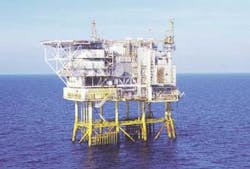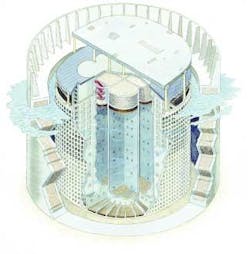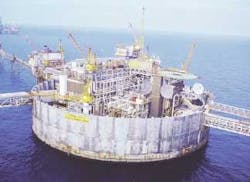Frigg and Ekofisk programs signal new era for abandonment
Nick Terdre
Contributing Editor
Platform decommissioning in the North Sea has been a long time coming, but upcoming abandonment projects on the Ekofisk and Frigg fields herald the start of a new level of activity.
ConocoPhillips is in the early stages of implementing its Ekofisk cessation plan, involving what is probably the world's most extensive offshore decommissioning program. A lengthy planning phase dating back to the early 1990s reached fruition last year when the company received all necessary approvals.
Under the plan, 15 platforms serving production and transport operations in the greater Ekofisk area, five of which are still in operation, will be decommissioned. All topsides and jackets will be brought to shore for final disposal (reuse, resale, or recycling). However, the concrete gravity-base of the Ekofisk Tank, 2/4 T, and the protective concrete wall that surrounds it, will be left in place following acceptance of this recommendation by the Norwegian government and the member countries of the Ospar Convention.
Drill cutting piles, pipelines, and umbilicals will also be left in place. The only significant change to the plan required by the Norwegian government was in the schedule for removal of the shutdown platforms, which is to be completed by 2013 rather than 2018 as proposed by the operator.
ConocoPhillips is now in the process of tendering three important implementation projects, each of which presents novel challenges. They are:
- The removal of the two redundant Ekofisk booster platforms through the use of new single-lift technology
- The cleaning of the Ekofisk Tank storage cells prior to the abandonment of the Tank's gravity-base structure
- The removal of the Tank topsides.
null
Booster platform bids
In May, the company invited bids from seven contractors offering concepts for removing the booster platforms with single-lift technology, including an option for disposal work. The bids are due back to the company later this summer, and ConocoPhillips aims to award a contract towards the end of the year, according to Kari Amundsen, manager of the Ekofisk I Cessation Project.
The seven contractors invited to bid and their concepts are:
- Aker Offshore Partner/Versatruss (Versa-truss)
- Excalibur Engineering (Pieter Schelte)
- Global Maritime/Prosafe (GM Lifter)
- Marine Shuttle (Offshore Shuttle)
- Master Marine (SeaFork One)
- MPU Enterprise (MPU Heavy Lifter)
- Seametric International (Twin Marine Lifter).
The two booster platforms, 36/22 A and 37/4 A, are located in the UK sector on the Norpipe oil export pipeline that runs from Ekofisk to Teesside. Both contain booster, pigging, control, and accommodation facilities, and are of similar weights: 36/22 A has a deck structure weighing some 2,052 metric tons and modules with a total of 3,311 tons, supported by an eight-leg 4,376-ton jacket, while 37/4 A has a 2,052-ton deck structure, 3,576 tons of modules and an eight-leg jacket, weighing 4,972 tons.
null
Last year the contractors participated in a development stage involving front-end engineering design (FEED). This work had a number of aims. It was intended to familiarize the contractors both with the platforms to be removed, and with the logistics challenges. Their remote location is almost three hours by helicopter from Stavanger.
This process also helped Cono-coPhillips to clarify some uncertainties in the concepts, some of which have been modified since they were first proposed. In addition, it enabled the contractors to provide an initial cost estimate for the job.
The experience of the development stage was generally positive and indicated that all seven concepts are technically feasible, says Amundsen. Only one, Versatruss, has so far been built and put into operation, basically in the Gulf of Mexico. All the other concepts exist only on the drawing board, which means the owners will need to have financial backing to build their vessels.
Last year, ConocoPhillips said it intended to award two contracts. However, based on a further assessment, the current strategy is to award one contract for the total scope of the removal of the two booster platforms, says Amundsen.
Tank cleaning
Cleaning of the Ekofisk Tank's nine storage cells is due to start in the first half of 2004 and be completed in early 2005. Last year, three contractors – Aker Offshore Partner, the Ekofisk Alliance, and Halliburton – carried out FEED work developing their proposed methods. All three proposed convincing methods, says Amundsen.
In late 2002, following the completion of this stage and a bid round between the three, a contract for preparatory engineering work was awarded to AOP. The main contract, for which AOP has an option on its present contract, is due to be awarded late this year.
The tank cells, which are 70 m high, are filled with water, with a layer of sediment at the bottom varying from 10 cm to 1 m thick in the different cells. A layer of oil and wax a few centimeters thick floats on top of the water.
null
The water cannot be removed, as this would threaten the integrity of the cell walls, so the sediments will have to be collected from beneath it. To provide better knowledge of the cell contents, eight have recently been entered to collect samples of the water and sediments. The plan is to recover the sediments and inject them into the reservoir through one of the Ekofisk injection wells.
The work involves removing the contaminated sediments from the bottom and the oil/wax layer from the top. No complete set of criteria or requirements for the cleaning operation currently exists. Water left in the cells will meet the standard required by the Norwegian Pollution Control Authority (SFT) for produced water. This is a challenging project, says Amundsen, not least because access to the cells has to be made through pipes that in some cases are only 70 cm (28 in.) in diameter.
A safety issue that must be resolved is the presence of hydrogen sulfide in the tank cells. The concentration level will have to be reduced before the cleaning operation starts.
Preparation of the base for abandonment also involves covering up seabed sediments that have entered either the inner annulus between the storage cells and the tank's breakwater wall, or the outer annulus between the tank and the protective wall.
Tank topsides removal
The tank topsides, which were installed in 1973-74, weigh 24,000 tons and comprise 82 modules. Some of these were lifted into place and some were actually built on the platform. There is also a "spaghetti" of pipework. Pipework and separators have already been steam-cleaned and chemical waste removed to shore.
A development stage was held last year, in which six contractors were awarded NKr 2 million contracts to perform FEED work describing their proposed removal method and the estimated costs. Bids for the removal contract were invited in April and are due back later this summer. Contract award is scheduled for late in the year, and the removal operations will take place in 2005. Six contractors pre-qualified for the work:
- ABB Offshore Systems
- AF Spesialprosjekt
- Aker Offshore Partner/Saipem
- Doris Engineering
- Global Maritime
- Wood GMC.
Three main methods have been proposed – a heavy-lift crane-barge, a crane specially mounted on the platform or on the protective wall (the so-called reverse Frigg approach, as some of the Frigg topsides were installed in this way), and the piece-small method. The last technique, which has been proposed by AF Spesialprosjekt, involves cutting up the modules into small packages that can be lifted by relatively light cranes. Norske Shell's Sola refinery in Stavanger was demolished in this way last year.
Removal of the topsides and preparation of the base for abandonment are due to be completed by 2008. A specialist company will be engaged to verify the tank cleaning work, which will also be monitored by a five-strong international scientific review group consisting of experts on marine environmental issues.
Once these three projects have been implemented, a significant part of the Ekofisk decommissioning will have been accomplished. Not only will the experience prove valuable for the industry as a whole, but success in the single-lift removal operations will provide Conoco-Phillips with an additional option for the removal of the 12 remaining platforms covered by the plan.
Plan near approval
By this fall, Total E&P Exploration Norge AS (Total Norge) expects to have received all necessary approvals for the Frigg cessation plan and is now preparing the first steps for implementing it. The process of gaining acceptance has been made complex because the field straddles Norwegian and UK waters, so the company has to seek approval from both governments.
In broad outlines, the plan proposes recovering the topsides of the five platforms and the steel jackets to shore, leaving the three concrete gravity-base structures (GBSs) in place, recovering the in-field pipelines, and leaving the two drill cuttings piles in place.
Both Oslo and London accepted the proposal for the GBSs and referred the matter to the Ospar Commission, the international body concerned with the marine environment of the north-east Atlantic, last September.
When it set guidelines in 1998 for the removal of offshore installations, Ospar accepted that concrete GBSs could be left in place if attempting to remove them proved technically unfeasible or presented safety risks. A number of questions were raised and satisfactorily answered, and when the four-month consultation period ended in January, no objections had been made, reports Tore Bø, Total's cessation project manager.
The final version of the plan, which has been amended in the course of consultation between the two governments and the contracting parties in the Ospar Convention, was issued in late May. This is the version that the UK government was expected to approve this summer.
For Oslo it is the second version of the plan, issued last November, which is the statutory document. Approval for the plan, with the exception of the GBS recommendation, will be given in Norway in the form of a royal decree.
The decree could have been issued earlier, but was put on hold partly because both governments wished to announce their approval at the same time, and partly to allow changes in Norway's law on the refund of decommissioning costs to come into effect. Under the new rules, all costs are treated as operating expenditure, which makes life easier, Bø says. The plan is priced at NKr 3.48 billion or £266.3 million, with about 50% falling due in each country. In addition, the cost of plugging and abandoning wells on DP2 and taking topside equipment out of service is estimated at NKr 1 billion or £80 million.
Cooperative spirit
"There has been a good process between us and the two ministries," says Bø. "The matter has been conducted in a cooperative spirit."
There have been a number of challenges due to the fact that Frigg lies on the median line between the UK and Norway, Bø says. The Frigg cessation process has brought the two sides closer together and they've ended up discussing issues of a more general nature. The Frigg Treaty has provided a good background for such cooperation, he says. The treaty, which regulates the transport of gas through the Frigg pipelines, came into effect in 1976 and was renewed in 1998.
The cessation process has also prompted mutually beneficial contacts between bodies in the two countries at a number of levels, including the relevant regulatory agencies, the Norwegian Pet-roleum Directorate and the UK Health & Safety Executive. The question of installing navigation aids on the GBSs following abandonment was considered by the UK's Northern Lighthouse Board and Norway's Coastal Directorate, resulting in a joint technical specification.
This summer Total will start a pre-qualification exercise for the removal operations. Toward the end of the year it expects to issue front-end engineering design contracts to half a dozen contractors, which will be followed by invitations to bid in summer 2004, with contracts awarded that fall.
The work will be divided into separate packages for topsides and jackets, possibly with a separate contract for each topside and each jacket. Removal operations are expected to start in the second half of 2005.
Deadline for complet
Total, which has participated in joint industry projects to develop new methods for platform rem-oval and for cutting up topside structures, has set a deadline of 2012 for completing the removal project. As one of the Ekofisk partners, the company will have access to the experience gained from using new single-lift technology for the removal of the two Ekofisk booster platforms. This will allow new single-lift contractors to seek to pre-qualify. One newcomer that expects to do so is Technip-Coflexip, which has carried out a number of studies concerning the use of its newly launched jackup rig concept for the removal of Frigg structures.
The removal operations are expected to be demanding and time-consuming. In broad outlines the plan proposes recovering the topsides of the five platforms and the steel jackets to shore, leaving the three concrete gravity-base structures (GBSs) in place, recovering the in-field pipelines and leaving the two drill cuttings piles in place. The five platforms are CDP1, TCP2 and TP1, which have concrete bases, and DP2 and QP.
The Frigg topsides are diversified, both in terms of functions, which range from drilling to process, compression, and accommodation, and in weight. The lightest weight is the 3,470-ton topsides of the QP accommodation platform, and the heaviest is the TCP2 platform's topsides, at 23,210 tons.
The topsides were installed in the 1970s, in most cases as small modules. In the case of CDP1, which has a topsides weighing 12,780 tons, construction took place on the platform with the aid of a crane specially mounted on the deck.
Removal will involve either reverse installation using a heavy-lift crane or the piece-small method using a platform-mounted crane. In the case of the three concrete platforms, the topsides will be removed down to the top of the shafts and all external steel will also be removed.
To avoid a "cold" phase between cessation of production and the start of offshore decommissioning operations, Total aims to have a hook-down contract in place by early 2004. That will allow removal preparations to begin as soon as the field ceases production.
The Frigg field is expected to cease production in 2004. The satellites tied back to the Frigg facilities have already been abandoned.
End of production is expected to be in spring 2004, though production could be maintained until the middle of that year. Hook-down will take place in parallel with the front-end engineering design work for the removal contracts. Using this approach, Total plans to exercise good control over safety, which it obviously recognizes as one of the leading issues. For the same reason, some existing platform personnel will be retained for this phase.
One of the first tasks will be well abandonment. In fact this has partly taken place, as newbuild jackup Mærsk Innovator completed the plugging and abandonment of 14 shut-in wells already on DP2 in June. A further 10 wells remain to be abandoned on DP2.
The two jackets, which support the DP2 and QP topsides, weigh 8,800 tons and 4,210 tons, respectively. Also to be removed is the wreck of the DP1 jacket, which weighs 6,900 tons and is standing un-piled on the seabed, having been damaged during installation.
Onshore disposal of the platforms will be contracted as subcontracts to the main removal contracts. Total will encourage a high degree of recycling, and will include incentives in the contracts for the contractors to achieve its targets.
All in-field pipelines and cables will also be retrieved and brought ashore for recycling or scrapping. There is a total of some 6.3 km of pipelines, including two 500-m lengths of 26-in. line, two 700-m lengths of 26-in. line and a further 500 m of 24-in. line. These are expected to be removed in 2011-12, once the platform removal operations have been completed.
Of the two 34-in. pipelines that export gas from Frigg to the UK, the UK-owned line will remain in operation carrying gas from Total's Alwyn North field in the UK sector as wells as other fields further downstream. Gas from Alwyn North, which currently enters the Frigg line via the TP1 platform, will be rerouted to bypass the platform and connect into the Frigg line subsea. The first 46 km of the Norway-owned Frigg line will be decommissioned, down to the point where the Vesterled line from Heimdal ties in with it.
Previous programs
Decommissioning activities have been under way in the Frigg area for some years now. In 1996, the Northeast Frigg facilities were brought ashore, as were the subsea facilities on East Frigg and Lille Frigg in 2001. Last summer, the Frøy platform was removed. Parts of the Northeast Frigg facilities – the control module and the column that supported it – were reused, as were the main parts of the East Frigg and Lille Frigg subsea facilities.
Earlier this year, Total demolished and recycled the 5,800-ton Frøy jacket, but it has stored the 2,500-ton topsides at Lyngdal Recycling's site in southern Norway in hopes that a buyer may emerge. Despite intensive marketing efforts, including the distribution of 30,000 CDs with Frøy and Lille Frigg specifications, and promotion on the web through Web Platform Brokers, Total has so far met with little success in securing reuse opportunities apart from the sale of equipment items.
The Frigg facilities are also available for reuse, but given their age and degree of wear, Bø expects that sales will be limited to oil production modules of more recent manufacture and equipment items.



